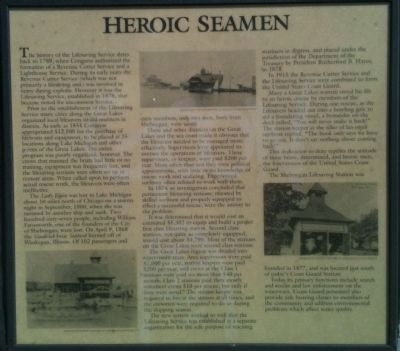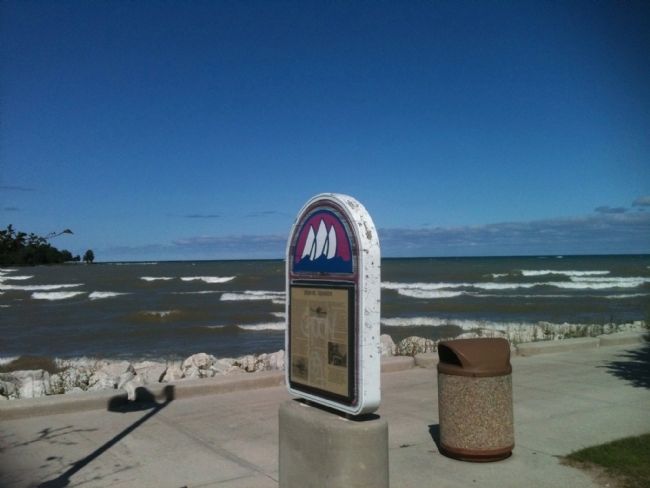Sheboygan in Sheboygan County, Wisconsin — The American Midwest (Great Lakes)
Heroic Seamen
Prior to the establishment of the Lifesaving Service many cities along the Great Lakes organized local lifesavers to aid mariners in distress. As early as 1854 Congress appropriated $12,500 for the purchase of lifeboats and equipment, to be placed at 25 locations along Lake Michigan and other points of the Great Lakes. The entire program was poorly organized, however. The crews that manned the boats had little or no training, equipment was frequently lost, and the lifesaving stations were often set up in remote areas. When called upon to perform actual rescue work, the lifesavers were often ineffective.
The Lady Elgin was lost in Lake Michigan about 16 miles north of Chicago on a stormy night in September, 1860, when she was rammed by another ship and sunk. Two hundred sixty-seven people, including William Farnsworth, one of the founders of the City of Sheboygan, were lost. On April 9, 1868 the Goodrich boat Seabird burned off Waukegan, Illinois. Of 102 passengers and crew members, only two men, both from Sheboygan, were saved.
These and other disasters on the Great Lakes and the sea coast made it obvious that the lifesavers needed to be managed more effectively. Supervisors were appointed to oversee the operations of lifesavers. These supervisors, or keepers, were paid $200 per year. More often than not they were political appointments, with little or no knowledge of rescue work and seafaring. Experienced surfmen often refused to work with them.
In 1874 an investigation concluded that permanent lifesaving stations, manned by skilled surfmen and properly equipped to effect a successful rescue, were the answer to the problem.
It was determined that it would cost an estimated $5,302 to equip and build a proper first class lifesaving station. Second class stations, not quite so completely equipped, would cost about $4,790. Most of the stations on the Great Lakes were second class stations.
The Great Lakes region was divided into supervisory areas. Area supervisors were paid $1,000 per year, station keepers were paid $200 per year, and crews at the Class 1 stations were paid no more than $40 per month. Class 2 stations paid their mostly volunteer crews $10 per rescue, but only if lives were saved. The station keeper was required to live at the station at all times, and the crewmen were required to do so during the shipping season.
The new system worked so well that the Lifesaving Service was established as a separate organization for the sole purpose of rescuing mariners in distress, and placed under the jurisdiction of the Department of the Treasury by President Rutherford B. Hayes, in 1878.
In 1915 the Revenue Cutter Service and the Lifesaving Service were combined to form the United States Coast Guard.
Many a Great Lakes seaman owed his life to an heroic rescue by members of the Lifesaving Service. During one rescue, as the Lifesavers headed out into a howling gale to aid a foundering vessel, a bystander on the deck yelled, "You will never make it back!" The station keeper at the tiller of his small surfboat replied, "The book only says we have to go out. It don't say nothing about coming back!"
This dedication to duty typifies the attitude of these brave, determined, and heroic men, the forerunners of the United States Coast Guard.
The Sheboygan Lifesaving Station was founded in 1877, and was located just south of today's Coast Guard Station.
Today its primary functions include search and rescue and law enforcement on the waterways. Coast Guard personnel also provide safe boating classes to members of the community and address environmental problems which affect water quality.
Topics and series. This historical marker is listed in these topic lists: Heroes • Military • Waterways & Vessels. In addition, it is included in the Lost at Sea series list. A significant historical month for this entry is April 1825.
Location. 43° 45.282′ N, 87° 42.125′ W. Marker is in Sheboygan, Wisconsin, in Sheboygan County. Marker can be reached from the intersection of Broughton Drive and New York Avenue, on the right when traveling north. The marker is near the beach in Deland Park. Touch for map. Marker is at or near this postal address: 901 Broughton Drive, Sheboygan WI 53081, United States of America. Touch for directions.
Other nearby markers. At least 8 other markers are within 2 miles of this marker, measured as the crow flies. Bustling Shipyards (here, next to this marker); Fiery Passage (approx. 0.2 miles away); The Home Fleet (approx. 0.2 miles away); Seils–Sterling Circus (approx. ¾ mile away); The Phoenix Tragedy (approx. ¾ mile away); Schooner Gallinipper (approx. ¾ mile away); North Point /Sheboygan Point (approx. ¾ mile away); Revolutionary War Veteran (approx. 1.6 miles away). Touch for a list and map of all markers in Sheboygan.
Credits. This page was last revised on June 16, 2016. It was originally submitted on September 25, 2011, by William J. Toman of Green Lake, Wisconsin. This page has been viewed 607 times since then and 22 times this year. Photos: 1, 2. submitted on September 25, 2011, by William J. Toman of Green Lake, Wisconsin. 3. submitted on April 21, 2011, by William J. Toman of Green Lake, Wisconsin.


